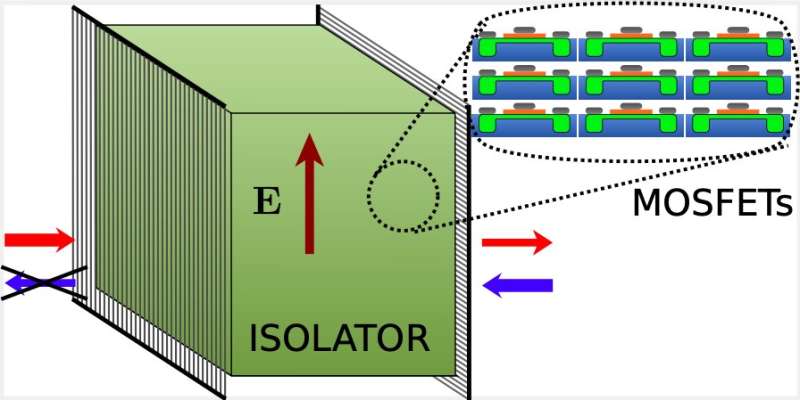Credit: Lannebère et al, DOI: 10.1103/PhysRevLett.128.013902
Transistors based on semiconductor materials are widely used electronic components with many remarkable properties. For instance, they have a nonreciprocal electrical response, which means that they can isolate two parts of a circuit in such a way that one of the parts (the input section) can influence the other part (the output section), but not the other way around. In addition, transistors can amplify voltage signals, and thereby can supply energy to a system. Non-energy conserving interactions are usually referred to as "non-Hermitian."
Researchers from Instituto de Telecomunicações at the University of Coimbra and University of Lisbon have recently introduced a new class of bulk materials that draws inspiration from the non-reciprocal and non-Hermitian responses of conventional semiconductor-based transistors. They presented these transistor-like three-dimensional (3D) bulk metamaterials in a paper published in Physical Review Letters.
Mário Silveirinha, one of the researchers who carried out the study, told Phys.org, "The ideas developed in our paper were mostly driven by the question: Would it be possible to somehow imitate the response of standard transistors in a bulk metamaterial? We were intrigued if it would be feasible to have a bulk material which, when suitably biased, could manipulate electromagnetic waves in the same way as a transistor manipulates a voltage signal."
A key objective of the recent study by Silveirinha and his colleagues was to identify a new way to obtain a nonreciprocal and/or non-Hermitian responses, which can be controlled by a static electric field in a photonic system. Systems that can be controlled using electric fields have significant advantages over more conventional solutions, such as those based on bulky magnetic circuits, as they are ubiquitous, can attain better performances and are easier to reduce in size.
"In our paper, we theoretically show that nonlinear materials with a broken inversion symmetry may have rather exotic non-Hermitian responses in nonequilibrium situations when biased by an electric field," Silveirinha said. "Specifically, we predicted that the interplay of a static electric field bias with material nonlinearities may result in a bulk nonreciprocal and non-Hermitian response, somewhat analogous to the response of a semiconductor MOSFET, but in a 3D bulk material."
The new 3D bulk metamaterials identified by the researchers could exhibit highly exotic physics. For instance, due to their non-Hermitian response, different field modes in them do not transport power independently and the interference between two waves can give rise to a so-called 'power beating." As a result of this beating, the same 3D bulk material could either behave as a gainy material (i.e., acquiring energy) or a lossy one (i.e., dissipating energy), depending on the field polarization.
"We introduced the idea of imitating the operation of transistors, which are point-type devices (i.e., with zero dimensions) in a 3D bulk metamaterial," Silveirinha said. "We believe that our work can have important practical applications, because of the superiority of electrically biased systems in terms of performance, integrability and miniaturization."
In the future, the transistor-inspired 3D bulk metamaterials introduced by this team of researchers could be used to create electromagnetic isolators, two-port devices that transmit energy in a single direction. These isolators could be a feasible alternative to Faraday isolators, devices that transmit light in a specific direction and block light in the opposite direction, which are commonly used to protect a laser source from destabilizing feedback or damage from back-reflected light.
"Electromagnetic isolators are highly important for the development of all-optical circuits, as typical communication systems are designed in a modular way (i.e., with modules that are supposed to perform specific tasks or process signals in a specific way)," Silveirinha explained. "Ideally, the response of a given module should be independent of the other modules to which it is connected to. For this to happen, it is essential to isolate the different modules, allowing only for 'one-way' (i.e., nonreciprocal) interactions."
In addition to enabling nonreciprocal interactions in devices, the newly identified metamaterials exhibit a non-Hermitian response, which means that they can amplify electromagnetic signals. In the future, they could thus also potentially be used to create terahertz lasers and terahertz amplifiers.
"There are many exciting paths to explore next, as the non-Hermitian and nonreciprocal response we identified may lead to different innovations and devices," Silveirinha said. "For instance, it can enable the realization of a new class of oscillators, distributed amplifiers, optical isolators and circulators and other devices for nanophotonics applications.
As part of their current research efforts, Silveirinha and his colleagues are exploring various possible practical implementations of their 3D bulk metamaterials. The most obvious among these might be to use them to create systems containing arrays of transistors.
"Our preliminary analyses show that when used to create transistor arrays, the metamaterials can indeed provide the desired responses," Silveirinha added. "We are now working on the experimental demonstration of a 1D version of such systems. We also believe that related responses can be realized using natural materials in non-equilibrium situations (e.g., with an injection current), and we are exploring that and other opportunities."
More information: Sylvain Lannebère et al, Nonreciprocal and Non-Hermitian Material Response Inspired by Semiconductor Transistors, Physical Review Letters (2022). DOI: 10.1103/PhysRevLett.128.013902
Journal information: Physical Review Letters
© 2022 Science X Network
























